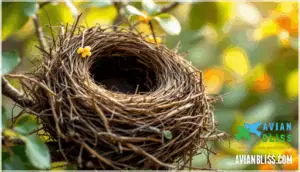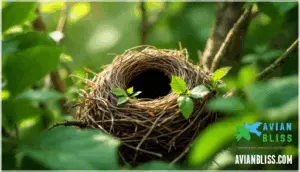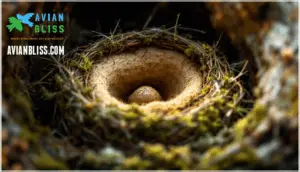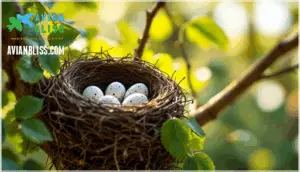This site is supported by our readers. We may earn a commission, at no cost to you, if you purchase through links.
 You’ve likely walked past a Carolina wren nest without even knowing it. These resourceful birds don’t limit themselves to tree hollows—they’ll tuck their domed nests into hanging flower baskets, old boots on porches, or coiled garden hoses. In fact, research shows that roughly 81% of suburban Carolina wren nests use human-made structures rather than natural cavities.
You’ve likely walked past a Carolina wren nest without even knowing it. These resourceful birds don’t limit themselves to tree hollows—they’ll tuck their domed nests into hanging flower baskets, old boots on porches, or coiled garden hoses. In fact, research shows that roughly 81% of suburban Carolina wren nests use human-made structures rather than natural cavities.
This adaptability has made them one of the few native songbirds thriving in developed areas. Understanding their nesting preferences reveals why your backyard might already be prime real estate for these energetic, rust-colored songbirds, and what you can do to support their surprisingly intricate breeding habits.
Table Of Contents
- Key Takeaways
- Carolina Wren Nesting Habits
- Nest Site Selection
- Nest Building and Construction
- Egg Appearance and Laying
- Incubation Period and Parenting
- Nesting Cycle and Breeding Season
- Nesting Challenges and Threats
- Attracting Carolina Wrens to Your Yard
- Carolina Wren Nesting Boxes and Placement
- Carolina Wren Nesting Success and Conservation
- Frequently Asked Questions (FAQs)
- How long do baby Carolina Wrens stay in the nest?
- Do Carolina wrens leave their eggs unattended?
- What month do wrens lay their eggs?
- How to safely observe Carolina Wren nests?
- What materials do Carolina Wrens use for nests?
- Can Carolina Wrens reuse old nests?
- How do Carolina Wrens defend their nests?
- What time of day do wrens build nests?
- Do Carolina Wrens reuse nests from previous years?
- How do Carolina Wrens react to nest competitors?
- Conclusion
Key Takeaways
- Carolina Wrens demonstrate remarkable nesting adaptability, with roughly 81% of suburban nests using human-made structures like flower baskets, mailboxes, and old boots rather than natural tree cavities, making them one of the few native songbirds thriving in developed areas.
- These monogamous birds form lifelong pair bonds and typically raise 2-3 broods per season from mid-March through September, with the female solely responsible for the 12-16 day incubation period while both parents share feeding duties once chicks hatch.
- Predation accounts for approximately 70% of nesting failures, with raccoons, snakes, squirrels, and domestic cats being the primary threats, though wrens show strong defensive behaviors including alarm calls and aggressive chases to protect their nests.
- The species has experienced a 71% population increase in the United States from 1970 to 2014, expanding their range northward due to climate warming, though northern populations remain vulnerable to harsh winter conditions that can eliminate local populations.
Carolina Wren Nesting Habits
Carolina Wrens aren’t picky about nesting, but they do have clear preferences that shape where and how they build their homes. Understanding their nesting habits—from site selection to construction techniques—can help you appreciate these adaptable birds or even encourage them to nest in your yard.
Let’s look at the key aspects of their nesting actions, starting with how they choose their sites.
Choosing Nesting Sites
Carolina Wrens are resourceful nest-site hunters. Studies show about 67% favor woodland edges—those boundary zones where trees meet open space—because they offer both shelter and easy foraging access. When you’re looking at nest site selection, you’ll notice four key preferences:
- Edge proximity: Nests cluster near woodland borders rather than deep forest or open meadows
- Substrate diversity: Natural cavities, stumps, and human-made objects like mailboxes or flowerpots
- Concealment metrics: Dense undergrowth and overhead canopy within a 1–10 meter radius
- Pilot nest locations: Males build up to four trial nests before females choose the final nesting site
About 75% of nest locations sit three to eight feet off the ground, commonly where vegetation provides cover. What’s more, males often build multiple trial nests during the breeding season.
In suburban areas, wrens use artificial substrates in roughly 81% of documented nestings, showing striking adaptability to human environments while maintaining their preference for sheltered, vegetation-rich spots.
Nesting Materials and Construction
Once your wrens pick their spot, they set to work gathering everything from twigs and bark strips to grasses, leaves, and even shed snakeskin—whatever’s within hopping distance gets woven into the frame. The male builds the outer shell during nest construction, while the female adds the soft lining—moss, feathers, and fine grass—ensuring structural integrity and nest camouflage. This construction timeline spans several days, producing a loosely woven cup roughly 6 inches across.
| Component | Material Selection | Function |
|---|---|---|
| Foundation | Twigs, bark strips, dried grasses | Provides nest dimensions and support |
| Mid-layer | Leaves, plant debris, moss | Adds insulation and structural integrity |
| Inner lining | Feathers, fine grass, hair | Cushions eggs and maintains warmth |
| Decorative | Shed snakeskin, paper strips | Boosts nest camouflage |
| Entrance dome | Curved twigs, vegetation | Protects cavity opening |
Nesting Cavity Selection
After your wrens finish weaving their cozy cup, they’re surprisingly flexible about where it actually sits—tree holes, stumps, old boots, and even your garage shelf all get equal consideration. Cavity size matters most—entrance holes 1–1.5 inches wide discourage larger predators while allowing easy access. Your wrens prioritize nest concealment through vegetation and material availability nearby, balancing microclimate preference with predator avoidance when evaluating each nest location:
- Natural tree cavities and rotted stumps
- Nest boxes with proper entrance dimensions
- Man-made structures like mailboxes or flowerpots
- Shrubby thickets offering dense cover
- Overhangs protecting against weather exposure
Nesting Height and Orientation
Most wrens don’t need a penthouse view—they’ll settle for cozy spots between 3 and 6 feet off the ground, where predators can’t easily reach but parents won’t wear themselves out with constant vertical commutes.
Your nest placement decisions should balance sun exposure for warmth with wind protection and camouflage needs—nesting site selection varies regionally, with northern populations favoring sheltered nest orientation while southern wrens tolerate more exposed nest locations.
| Nesting Factor | Ideal Height Range | Regional Variations |
|---|---|---|
| Sun Exposure | Partial shade preferred | Southern sites need more cover |
| Wind Protection | Sheltered east-facing spots | Northern wrens prioritize protection |
| Camouflage Needs | Dense vegetation at 3–6 ft | Consistent across nesting sites |
| Predator Avoidance | Mid-level nest location | Ground-dwelling threats vary |
| Accessibility | Easy parent access paths | Terrain influences nest site choices |
Nest Site Selection
Carolina Wrens aren’t picky about where they set up shop, but they do have preferences that guide their choices. Understanding what attracts these birds to specific locations can help you recognize potential nest sites in your yard or local area.
Let’s look at the four main factors that influence where Carolina Wrens decide to raise their young.
Natural Cavities and Hollows
You’ll often find Carolina Wrens nesting in natural cavities formed by decay or woodpecker excavation in tree trunks and stumps. These secondary cavity nesters prefer hollows 3 to 6 feet above ground, which offer shelter from weather and predators. In eastern forests, cavity availability directly impacts nesting success—mature deciduous trees provide the best hollow characteristics. However, cavity competition with chickadees, titmice, and bluebirds can affect nest site selection and breeding outcomes. Nest boxes also provide suitable nesting locations.
- Hollows generally measure 3 to 9 inches long with side entrances
- Wrens line cavities with bark strips, moss, and feathers
- Natural crevices in stones or roots serve as alternative nesting sites
- Cavity occupancy rates exceed 50% in prime habitat areas
- Hollow selection reduces predation risk compared to open nests
Man-Made Structures and Nest Boxes
Beyond tree hollows and stumps, you’ll discover Carolina Wrens readily adapting to an impressive array of human-made structures—from mailboxes and flowerpots to garage shelves and porch rafters.
Their nesting site flexibility makes nest boxes particularly effective when designed with proper size dimensions (4x4x8 inches), entrance size (1-1.5 inches), and mounting height (5-10 feet). Select box material like cedar for durability, and consider camouflage design to reduce predation during nest building.
Vegetation and Foliage
Carolina Wrens don’t just settle for any spot—they gravitate toward areas where thick undergrowth and layered vegetation create a natural fortress for their nests. You’ll find them thriving in shrubby areas and wooded habitats where foliage provides essential cover from predators and harsh weather.
Dense undergrowth in overgrown farmland or residential trees offers ideal nesting conditions:
- Tangled vines and brambles shield nest sites from view
- Multiple vegetation layers provide year-round protection
- Native shrubs attract insects for convenient foraging near nests
Proximity to Food and Water Sources
When you’re raising a family, you don’t want to commute miles just to grab groceries—and Carolina Wrens feel the same way about their nesting sites. These birds select nest locations within short foraging distance of reliable food sources, particularly areas with high insect abundance. You’ll notice Carolina Wrens favor nesting sites near water proximity, which aids both hydration needs and thriving vegetation that attracts their prey.
The presence of backyard feeders can influence Carolina Wren nesting decisions, though they primarily rely on natural food sources like caterpillars and beetles. Wrens forage within 16 feet of the ground near their nests, so source reliability matters greatly. When insects are plentiful and water is accessible, nesting success improves markedly, reducing the stress of long foraging trips during the demanding breeding season.
Nest Building and Construction
Once you’ve picked the perfect spot, Carolina Wrens get to work building their nest with considerable dedication and teamwork. The male usually constructs several preliminary nests before the pair settles on one, and then both birds collaborate to finish the job.
Understanding what they use and how they build helps you appreciate these resourceful little architects.
Materials Used for Nesting
Like a skilled architect gathering blueprints, Carolina Wrens collect an impressive mix of materials to build their sturdy nests. You’ll find they gather bark strips and dried grasses as foundational elements, then add moss selection for soft lining.
Their nesting actions also include the creative use of:
- Leaves and plant debris
- Feathers for insulation
- Human-made materials like string or paper
This nest construction process demonstrates their adaptable approach to nest building across various nesting sites.
Nest Shape and Design
You might think a wren’s nest is just a simple cup, but Carolina Wrens are surprisingly inventive builders who often add architectural flair to their designs. When nesting in open locations, they construct dome-shaped structures with a distinctive side entrance, carefully arranging materials to create a protective roof. In cavity nests, they build a classic cup shape instead, adapting their nest construction to whatever space they’ve chosen.
The nest dimensions commonly measure three to six inches across, and their material arrangement showcases impressive weaving skills that guarantee stability and warmth.
Entrance and Exit Points
Once you’ve admired the wren’s clever dome or cup construction, the next detail worth noting is how they design their entryway—a strategic feature that balances accessibility for the parents with protection from unwanted visitors. Carolina Wrens favor nest entrance openings that measure roughly one to two inches across, a cavity size small enough to deter larger predators while allowing easy passage for the breeding pair. The orientation angles of these entrance points often face away from prevailing winds and direct sunlight, enhancing nest concealment within the nesting site.
Here’s what makes their entrance design effective:
- Cavity size remains compact to prevent raccoons, squirrels, and snakes from reaching eggs or chicks inside the nest location.
- Accessibility factors include clear flight paths so parents can quickly enter and exit when delivering food or responding to threats.
- Predator avoidance through strategic placement means nest boxes and natural nest sites with partially obscured openings offer better protection than fully exposed entrances.
Lining and Insulation
After establishing secure entrance points, the female wren shifts her attention to creating a soft interior lining that will cradle eggs and protect developing chicks from temperature extremes. She selects nesting material with excellent thermal properties—moss, fine grass, and feathers—to form the nest cup shape. This careful nest construction guarantees suitable conditions for successful incubation and chick development.
| Material Type | Insulation Techniques | Material Availability |
|---|---|---|
| Moss | Traps air pockets for warmth | Common in moist habitats |
| Feathers | Provides lightweight softness | Scavenged from other birds |
| Fine grasses | Weaves flexible cup structure | Abundant in residential areas |
| Animal fur | Adds nest material softness | Collected opportunistically |
This nest lining provides important insulation against cold nights and hot days.
Egg Appearance and Laying
Once your Carolina Wrens have completed their nest, you’ll soon notice the eggs appearing in the cozy chamber. Understanding what these eggs look like and how the laying process unfolds can help you recognize what’s happening during this exciting stage.
Let’s look at the key details about Carolina Wren eggs and their laying patterns.
Eggshell Color and Pattern
Carolina Wren eggs wear a distinctive wardrobe of creamy white adorned with reddish-brown speckles, creating a camouflage pattern that helps protect the clutch from predators while nestled in their chosen cavity. These markings result from pigment deposits during egg formation, with spot distribution varying across each egg’s surface.
You’ll notice three key egg characteristics:
- Genetic factors influence the intensity and density of reddish-brown dots on the creamy-white base.
- Regional variations may affect overall egg appearance, though differences remain subtle.
- Camouflage function works best when speckles concentrate at the larger end, breaking up the egg’s outline.
The egg description remains fairly consistent across the species’ range.
Egg Size and Shape
Though speckled and distinctively patterned, each Carolina Wren egg measures approximately 0.6 inches long and 0.5 inches wide, displaying the elliptical form typical of cavity-nesting birds. This shape variation helps eggs fit snugly together, maximizing warmth during incubation while reducing breakage risk within confined nesting cavities.
| Egg Characteristics | Measurement | Description |
|---|---|---|
| Egg Length | ~0.6 inches | Standard dimension across clutches |
| Egg Width | ~0.5 inches | Slightly narrower than length |
| Egg Volume | Small | Proportional to Carolina Wrens’ body size |
The eggshell thickness provides adequate protection without compromising the developing embryo’s gas exchange needs.
Clutch Size and Frequency
Across their eastern range, most Carolina Wrens lay between four and six eggs per clutch, with southern populations occasionally producing up to eight. You’ll notice these birds generally raise two broods during the breeding period from mid-March through September, though Florida and Texas residents may complete three successful broods. Northern clutches face shorter breeding windows, limiting pairs to two nesting attempts annually.
- Clutch size averages 4–6 eggs, with occasional egg variation reaching 8
- Southern broods benefit from extended warm seasons
- Brood number increases southward due to favorable clutch factors
- Food availability and temperature strongly influence egglaying success
Egg Laying and Incubation Period
Female Carolina Wrens lay one egg per day—usually in the early morning—until they complete the clutch, then settle in for about two weeks of solo incubation. During this incubation period, the female rarely leaves the nest, relying on stored body reserves and occasional feeding visits from her mate.
You’ll notice she maintains precise temperature regulation throughout egg development, turning the eggs regularly to guarantee uniform warmth. The hatching process begins around day 12–16, with chicks emerging nearly featherless and entirely dependent on both parents for food.
Incubation Period and Parenting
Once the female Carolina Wren settles in to warm her clutch, the incubation period begins, and both parents prepare for the demanding work ahead. This stage involves careful temperature regulation, coordinated feeding efforts, and attentive care as the chicks grow from helpless hatchlings to fledglings ready to leave the nest.
Here’s what you need to know about how Carolina Wrens manage incubation and raise their young.
Incubation Duration and Temperature
If you’ve ever wondered how long those tiny speckled eggs need to stay warm before they hatch, the answer is roughly 12 to 16 days of steady incubation. During this Carolina Wren incubation period, the female maintains consistent egg temperature through direct body contact, securing proper thermal regulation. The nest’s materials and shaded location help control nest humidity and temperature fluctuations, which are critical for successful development.
Key factors supporting incubation of the eggs:
- Stable warmth: The female rarely leaves, keeping eggs at ideal temperature
- Natural insulation: Moss, feathers, and grass regulate heat retention
- Protected placement: Shade prevents overheating during warm days
Parental Roles and Responsibilities
While the female manages nearly all of the incubation duties solo, both parents spring into action once the eggs hatch, sharing feeding and protection responsibilities in a well-coordinated partnership. The male contributes substantially to chick rearing, making frequent foraging trips to gather insects while the female broods young nestlings. Together, their coparenting roles guarantee avian parenting success, with nest defense becoming a shared duty as both adults aggressively drive away potential threats during Carolina Wren chick development.
| Parenting Aspect | Female Care | Male Parenting |
|---|---|---|
| Incubation | Manages 100% of egg warming | Occasionally brings food to incubating mate |
| Brooding hatchlings | Stays with chicks to regulate temperature | Increases foraging frequency for protein-rich prey |
| Feeding trips | Shares equally once chicks are feathered | Delivers caterpillars, spiders, beetles continuously |
| Nest defense | Vocalizes alarm calls, dive-bombs intruders | Aggressively confronts predators near cavity |
| Post-fledging care | Guides fledglings to safe perches | Continues feeding until independence achieved |
This Carolina Wren parental care system demonstrates impressive cooperation, with both adults investing heavily in fledging Carolina Wren chicks successfully.
Brood Size and Nestling Development
You’ll find clutch sizes usually range from 4 to 5 eggs per nest, though some pairs produce up to 8. Nestling development unfolds rapidly over 12-14 days, with hatchlings doubling their body mass as both parents deliver insects constantly.
Brood parasitism by cowbirds affects roughly 25% of nests, while fledgling survival hovers around 50% once young wrens leave the cavity—developmental milestones that directly impact your backyard population’s success.
Fledging and Nest Departure
Young wrens don’t just hop out of the nest—they launch into one of the riskiest transitions of their lives, where every decision in those first few hours can mean the difference between survival and becoming a predator’s next meal. Fledging occurs around 12-14 days after hatching, when the nestling period ends and nest departure timing begins. Post-fledging survival depends on three factors:
Young wrens fledge at 12-14 days, launching into a perilous transition where survival hinges on split-second decisions in their first hours outside the nest
- Parents guide juveniles to safe perches during nest exit strategies.
- Fledgling care continues 2-3 weeks as adults teach foraging skills.
- Juvenile dispersal begins once nesting conduct shifts toward independence.
Nesting Cycle and Breeding Season
Understanding when and where Carolina Wrens nest helps you know what to expect if a pair sets up shop in your yard. These birds follow a predictable breeding pattern tied to climate and habitat, though they’re remarkably flexible in their choice of nesting locations.
Let’s look at the key aspects of their nesting cycle, from their geographic range to how they defend their territory.
Breeding Range and Habitat
From the warm forests of Florida to the increasingly hospitable woodlands of southern Canada, Carolina Wrens have steadily expanded their breeding territory across eastern North America. Their breeding range now stretches from northeastern Mexico through the Yucatan Peninsula, covering states like Georgia, Illinois, and Massachusetts.
Habitat selection centers on brushy thickets, bottomland woods, residential areas with dense undergrowth, and overgrown farmland. Climate warming has driven this northward range expansion, though northern populations remain vulnerable to harsh winters affecting nesting success.
Nesting Season and Frequency
Once you’ve identified where Carolina Wrens like to live, understanding when they actually settle down to raise their young helps you anticipate their presence in your yard. The breeding period runs from mid-March through late September, giving these persistent nesters ample time to raise multiple broods. Here’s what makes their nesting season noteworthy:
- Multiple nesting attempts mean 2-3 broods per season
- Clutch sizes usually include 4-5 creamy eggs with reddish-brown dots
- Regional differences affect timing—northern populations start later
- Seasonal variations in weather influence nesting success rates
This extended breeding timeline and clutch frequency reflect Carolina Wren nesting habits shaped by climate and food availability.
Mating and Pair Bonding
Unlike many birds that form seasonal partnerships, Carolina Wrens choose their mates for life, building a partnership that lasts through every nesting season and every quiet winter month. Pairs primarily form in fall, though bonding can happen anytime.
These monogamous species stay together year-round, foraging cooperatively and defending their territory as a unified team. Divorce rates are extremely low—once a pair bonds, they remain devoted partners.
You’ll often see them traveling together, calling back and forth, their courtship rituals reinforced through cooperative actions that strengthen their lasting bond.
Territorial Behavior and Defense
Carolina Wrens don’t just defend their nests—they guard their entire territory with the kind of bold intensity you’d expect from birds far larger than their five-inch frames. Year-round territorial conduct includes aggressive song patterns and agonistic displays toward intruders.
Males use loud vocalizations as territorial marking, establishing borders through persistent vocal defense strategies. Border disputes involve dramatic chases, wing-fluttering confrontations, and coordinated defense by monogamous pairs protecting their Carolina Wren territory together, guaranteeing mate attraction success and breeding resources remain secure.
Nesting Challenges and Threats
While Carolina Wrens are adaptable nesters, they face real obstacles that can derail their breeding efforts. Predators, harsh weather, and human activity all pose risks to eggs, nestlings, and even adult birds. Understanding these threats helps you appreciate the challenges these small birds navigate each nesting season.
Predation and Nesting Failure
Predation of Carolina Wren nests accounts for roughly 70% of nesting failure. Raccoons, black rat snakes, gray squirrels, and domestic cats are the main culprits behind egg predation and brood loss. Nestlings face the greatest risk during their first two weeks, when nest defense by parents naturally decreases.
Common predators include:
- Raccoons and gray squirrels targeting eggs and chicks
- Black rat snakes in forested habitats
- Domestic cats in suburban areas
- Cooper’s Hawks occasionally hunting adults
Wrens show strong predator avoidance, responding to threats over 80% of the time with alarm calls and defensive chases, which markedly improves brood survival.
Human Disturbance and Habitat Destruction
Despite their adaptability, Carolina Wrens face mounting pressure from human activities that shrink their nesting habitats and disrupt their breeding cycles. Urbanization reduces suitable nest sites by converting forests into developments, while habitat fragmentation isolates populations. Noise pollution from traffic and construction can trigger nest abandonment during incubation. Pesticide use eliminates insects essential for feeding nestlings, and frequent human disturbance near active nests increases stress levels, sometimes leading to complete nest disturbance and breeding failure.
| Human Impact | Effect on Carolina Wren Habitat |
|---|---|
| Urban sprawl | Destroys natural nest cavities and foraging areas |
| Lawn pesticides | Eliminates insect prey needed for chicks |
| Construction noise | Causes nest abandonment during critical periods |
| Habitat clearing | Removes dense undergrowth essential for shelter |
| Cat populations | Increases nest predation rates in suburbs |
You can minimize ecosystem disruption by preserving brushy areas and avoiding chemical treatments in your yard during nesting season.
Climate Change and Weather Extremes
As global temperatures climb and weather patterns become less predictable, Carolina Wrens are pushing their range northward while facing the brutal reality that a single harsh winter can wipe out entire local populations. Climate modeling shows extreme weather events disrupt avian nesting cycles, with icy conditions reducing nesting success and forcing birds to adjust their winter survival strategies.
You’ll notice Carolina Wren nesting conduct adapting as climate change reshapes their traditional territories. Here are some key impacts:
- Temperature shifts delay spring breeding timing
- Severe ice storms eliminate insect prey availability
- Unpredictable cold snaps cause nest disturbance mid-incubation
- Extended droughts reduce dense undergrowth for shelter
- Sea level rise threatens coastal breeding habitats
Disease and Parasites
While harsh weather may seem like the biggest threat to nesting Carolina Wrens, invisible enemies—diseases and parasites—can silently undermine even the healthiest-looking nest. Avian malaria, fungal infections, and brood parasitism can compromise chick survival, while nest predation by avian predators often follows disease transmission. You’ll protect your wrens through parasite control and nest sanitation—keeping feeders clean prevents disease spread, and minimizing nest disturbance helps maintain healthy conditions throughout the breeding cycle.
| Threat Type | Common Examples | Impact on Nesting |
|---|---|---|
| Blood Parasites | Avian malaria, Haemoproteus | Weakens adult birds, reduces incubation success |
| Ectoparasites | Mites, lice, blowfly larvae | Drains nestling energy, increases mortality rates |
| Fungal Infections | Aspergillosis, nest mold | Compromises respiratory health, contaminates eggs |
| Brood Parasitism | Brown-headed Cowbirds | Cowbird chicks outcompete wren nestlings for food |
| Bacterial Diseases | Salmonella, E. coli | Spreads through contaminated feeders, causes nestling death |
Attracting Carolina Wrens to Your Yard
If you want Carolina Wrens calling your backyard home, you’ll need to create the right conditions. These birds look for specific features when they’re scouting nesting territory, and meeting those needs isn’t complicated.
Let’s look at four practical ways to make your yard more appealing to these vocal, energetic birds.
Providing Nesting Sites and Materials
You don’t need fancy gear to roll out the welcome mat for Carolina Wrens—just a few thoughtful touches that mimic what they’d find in nature. Consider adding nest boxes with proper birdhouse design, positioning them in sheltered spots where site preparation facilitates safe nest construction. You can also leave nesting materials like twigs, bark strips, and dried grasses nearby for their nest description-worthy creations:
- Nest box placement: Mount boxes 3–6 feet high in sheltered areas
- Material selection: Offer natural items like moss, leaves, and feathers
- Nesting platform: Provide open shelves or ledges as alternatives
- Nest site selection: Ensure protection from wind and predators
Offering Food and Water Sources
Think of your yard as a full-service diner for Carolina Wrens—stock the menu right, and they’ll become regulars. Suet feeders with added mealworms are your best bet, since the Carolina Wren diet relies heavily on insects for winter survival.
Position feeding stations near brushy cover where wrens naturally forage. Fresh water features, like shallow birdbaths, complete the spread and keep these energetic insect feeders coming back.
Creating a Wren-Friendly Habitat
Building on the food and water setup, the surrounding landscape matters just as much—wrens need the right mix of cover, clutter, and cozy spots to settle in permanently. Your yard layout should mimic their natural Carolina Wren habitat: think brushy corners with native plantings, tangled undergrowth near bird feeders, and water features tucked into sheltered zones. Garden diversity is what draws them in.
- Dense thickets of rhododendron or brambles for foraging cover
- Leaf litter and brush piles left undisturbed for insect hunting
- Layered vegetation from ground shrubs to tree canopy for nesting habits
Avoiding Pesticides and Herbicides
Chemical pesticides don’t just kill pests—they wipe out the very insects Carolina Wrens depend on to feed themselves and their chicks. When you choose organic gardening and chemical-free methods, you’re protecting the bird habitat while fostering Carolina Wren nesting habits. Sustainable landscaping with green practices creates a thriving insect feeder network. Here’s how eco-friendly choices affect conservation status:
| Approach | Impact on Wrens |
|---|---|
| Chemical pesticides | Eliminates essential insect prey, disrupts avian nesting |
| Organic methods | Sustains food sources, fosters healthy reproduction |
| Herbicides on lawns | Reduces ground-foraging insects like beetles, crickets |
| Native plant gardens | Attracts diverse insects, strengthens nesting success |
Your yard becomes a safe haven when you let nature manage pest control—ladybugs, spiders, and ground beetles do the work while wrens feast on the surplus.
Carolina Wren Nesting Boxes and Placement
If you want to give Carolina Wrens a helping hand, setting up the right nest box can make all the difference. The key is getting the design, placement, and upkeep right so these resourceful birds feel at home.
Here’s what you need to know to create an inviting nesting spot in your yard.
Nest Box Design and Size
A well-designed nest box can make all the difference between an empty box gathering dust and one housing a thriving Carolina Wren family. The key is mimicking what these birds naturally seek. Focus on three essentials:
- Hole size: Keep the nest entrance around 1½ inches in diameter.
- Box depth: Aim for 8 inches from floor to roof.
- Materials: Use untreated wood with a slanted roof design for drainage.
These dimensions match their nesting habits perfectly, guaranteeing comfortable mounting height and proper nest location for successful breeding.
Placement and Orientation
Once you’ve picked the perfect box design, where you put it matters just as much as what you build. Carolina Wren nesting habits favor sheltered nest locations, so mount your box 5 to 10 feet high on a tree cavity, sturdy branch placement, or building wall.
Face the nest orientation east or northeast to dodge harsh afternoon sun and prevailing winds.
Position it near dense undergrowth or shrubs where these wrens naturally forage, giving them quick cover from predators while maintaining their nesting habits of staying close to protective vegetation.
Installation and Maintenance
Mounting your box securely and keeping it in good shape takes just a few simple steps—but getting them right makes all the difference for your wrens. Use sturdy mounting hardware on a tree trunk or building wall, guaranteeing the box won’t shift during nest construction.
Site preparation means checking for predator access points and confirming proper drainage.
Clean your nest boxes each fall after fledging, removing old nesting materials to prevent parasites and support healthy nesting habits for next season’s nest site selection.
Monitoring and Maintenance
Keeping tabs on your nest box throughout the season helps you catch problems early and celebrate those tiny triumphs when chicks finally take flight. Check weekly from a respectful distance, watching for nesting activity without causing nest abandonment.
Install Predator Deterrents like baffles, practice proper Nest Cleaning between broods for nest hygiene, and conduct Wren Health Checks to monitor development.
Habitat Monitoring protects against nest predation while supporting successful nest protection.
Carolina Wren Nesting Success and Conservation
Carolina Wrens are doing well across eastern North America, but their nesting success depends on several factors we can influence. Understanding population trends, protecting habitat, and adapting to climate shifts all play a role in keeping these birds thriving.
Let’s look at what you can do to support Carolina Wren conservation in your own backyard and beyond.
Population Trends and Conservation Status
Carolina Wren populations have climbed steadily—up 71% in the United States from 1970 to 2014, according to Partners in Flight data. You’ll find roughly 18 million individuals now thriving across eastern North America, a proof of the species’ resilience and adaptability.
Conservation Efforts remain minimal because this bird’s Continental Concern Score of 7 out of 20 signals low risk.
Climate Impact continues shaping Population Growth, especially as milder winters fuel northward range expansion while periodic cold snaps still threaten northern populations.
Habitat Preservation and Restoration
Protecting the right mix of dense undergrowth, wooded edges, and shrubby thickets gives Carolina Wrens the foundation they need to nest successfully year after year. You can support habitat restoration by connecting fragmented woodlands through wildlife corridors, removing invasive plants that crowd out native vegetation, and preserving brushy areas where wrens forage and build nests.
Community involvement in conservation efforts strengthens ecosystem balance, securing these vocal songbirds continue thriving across their geographical distribution.
Climate Change Mitigation and Adaptation
Rising temperatures and unpredictable weather patterns are reshaping the landscapes Carolina Wrens depend on, forcing these adaptable birds to adjust their nesting strategies in real time. You can support their ecosystem resilience through targeted actions that reduce your carbon footprint while addressing temperature shifts affecting avian life cycles:
- Plant native vegetation that tolerates changing weather patterns and sustains insect populations wrens need during breeding season.
- Install well-insulated nest boxes that buffer temperature extremes and protect Carolina Wren nesting habits from heat stress.
- Maintain year-round water sources as droughts intensify and sea level rise alters coastal habitat availability.
- Reduce pesticide use to preserve the invertebrate prey base essential for successful nesting habits and chick development.
These practical steps directly counter climate change impacts on Carolina Wren populations while strengthening habitat quality across their breeding range.
Community Engagement and Education
When neighbors share backyard sightings and local naturalists document nesting attempts, you’re not just observing Carolina Wrens—you’re building a network that turns curiosity into conservation action.
Public outreach through wildlife workshops and birding events transforms your backyard birding experience into environmental education that matters.
Community programs teach attracting Carolina Wrens to your yard while providing safe nesting locations, directly improving Carolina Wren conservation status.
Understanding Carolina Wren nesting habits through shared observations strengthens collective stewardship of these resilient songbirds.
Frequently Asked Questions (FAQs)
How long do baby Carolina Wrens stay in the nest?
Like a dial-up modem connecting to the internet, baby Carolina Wrens need about 12 to 16 days before fledging from the nest. During this nestling care period, both parents feed the young constantly.
After nest departure, juveniles follow their parents for several weeks, refining their foraging skills and learning Carolina Wren nesting conduct essentials for future breeding cycles.
Do Carolina wrens leave their eggs unattended?
Female Carolina Wrens don’t usually abandon their eggs during incubation. She alone incubates the clutch, sitting for long periods while maintaining warmth and protection.
Males occasionally bring food to incubating females, allowing brief breaks for feeding and stretching. This dedicated parental care promotes maximum brood survival throughout the incubation period.
What month do wrens lay their eggs?
From mid-March through late September marks the breeding period for Carolina wrens, with egg laying peaking during spring and early summer.
You’ll notice their nesting cycles begin when temperatures warm, allowing multiple broods throughout this extended season.
Incubation periods start immediately after clutch completion.
How to safely observe Carolina Wren nests?
Observation begins with stillness and distance. Use binoculars to watch Carolina Wren nesting conduct without approaching, keeping Safe Observation Tips in mind. Minimize noise and movement near nest boxes or Nesting Habitat Creation areas.
Nest Cam Installation allows remote Wren Conduct Study in Bird Friendly Gardens while Protecting Carolina Wren nests from Disturbing nesting Carolina Wrens.
What materials do Carolina Wrens use for nests?
You’ll spot these wrens gathering twigs and leaves as their main framework, along with bark strips for structure.
They line the interior with soft materials like moss, grass, and feathers, creating a cushioned bowl. Plant debris gets woven throughout, forming a loosely constructed but functional nest.
Can Carolina Wrens reuse old nests?
Think of it like Goldilocks searching for the perfect bed—these resourceful wrens rarely reuse old nesting sites, preferring to start fresh each breeding season. Their nesting habits prioritize clean, safe environments for their young. Old nesting material can harbor parasites and bacteria, so Carolina Wren nesting habits involve constructing new structures, even when nest boxes or reclaimed nests are available.
Males build multiple options, letting females choose the best spot. This nest recycling avoidance guarantees healthier broods and reflects their adaptive nesting material selection strategies throughout the breeding period.
How do Carolina Wrens defend their nests?
You’ll notice pairs defending their territory with bold vocalizations and physical confrontations. Their Nest Defense Strategies include loud alarm calls, dive-bombing intruders, and Aggressive Conduct toward Nest predators like snakes and squirrels.
Territorial Marking through persistent singing reinforces boundaries, while Nest Camouflage in dense vegetation provides Predator Avoidance, reducing Carolina Wren nesting problems.
What time of day do wrens build nests?
You’ll notice nest building happens mostly during daylight hours, especially in the morning when Carolina Wrens are most active.
These energetic birds weave twigs, leaves, and bark strips into cozy dome-shaped nests throughout the nesting season, with both males and females contributing to construction during their daily nesting routines.
Do Carolina Wrens reuse nests from previous years?
No, Carolina Wrens usually don’t reuse nests from previous years. Their nest reuse patterns show they prefer building fresh nests each nesting season.
Males construct multiple options before breeding, demonstrating strong nesting site fidelity to locations rather than structures themselves.
How do Carolina Wrens react to nest competitors?
You know the saying: the best defense is a good offense. Carolina Wrens defend their nests vigorously through aggressive actions, including loud vocalizations and direct attacks on intruders, while using territorial marking to discourage competitors from approaching nest sites.
Conclusion
Think of Carolina wren nesting as nature’s version of claiming that perfect apartment—location matters, but adaptability seals the deal. By understanding their resourceful site selection, domed construction techniques, and seasonal breeding patterns, you can transform your yard into prime nesting territory.
Whether you’re installing a properly sized nest box or simply leaving that old watering can undisturbed, you’re supporting a species that’s mastered the art of thriving alongside humans. Their persistent song becomes the soundtrack to successful coexistence.
- https://avianreport.com/carolina-wren-nest-and-eggs/
- https://blog.nature.org/2021/02/10/carolina-wrens-will-nest-in-just-about-anything/
- https://ojs.library.okstate.edu/osu/index.php/OAS/article/view/7210/6643
- https://nestwatch.org/learn/focal-species/carolina-wren/
- https://txtbba.tamu.edu/species-accounts/carolina-wren/















